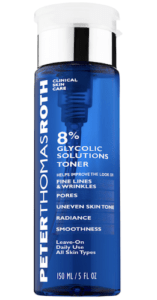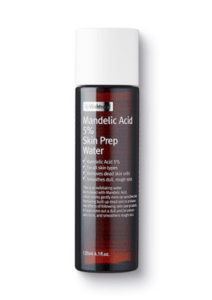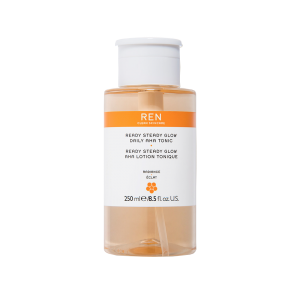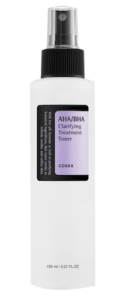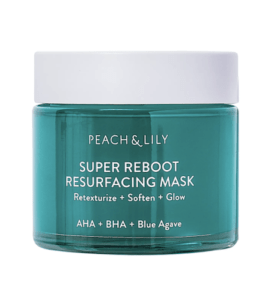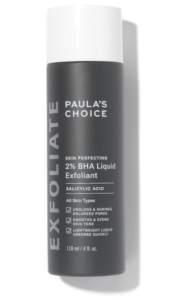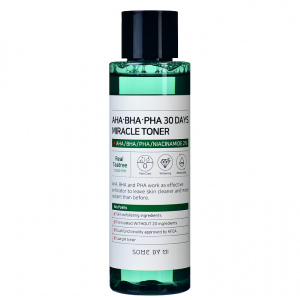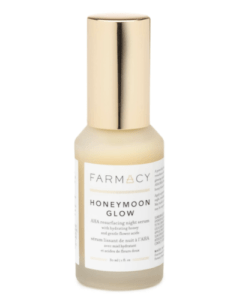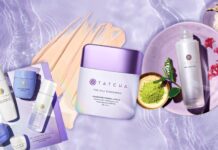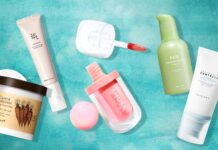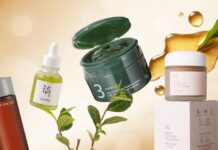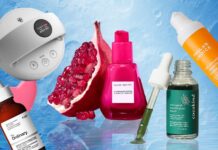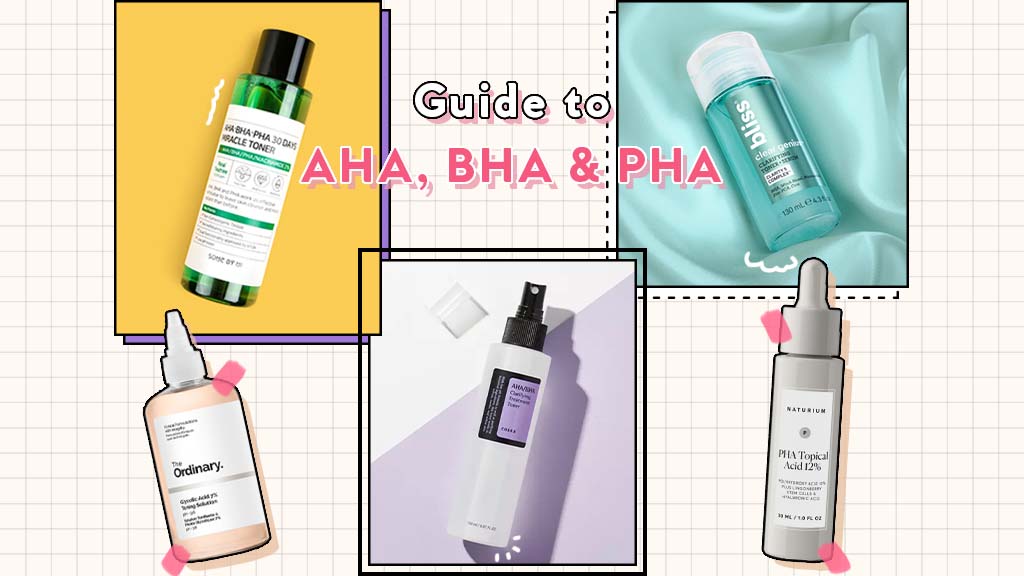
When you’re dealing with dull, flaky, and breakout-prone skin, you’ve probably heard about how chemical exfoliation such as AHA, BHA, and PHAs can help. If you’re new to the skincare game, don’t worry – we’re here to break each chemical exfoliant down for you.
What is a chemical exfoliant & how does it benefit the skin?
We get you – chemical exfoliant sound kind of intimidating. After all, the thought of slathering acids onto our skin sounds like something you’d see in a horror movie.
But rest assured, when used properly, chemical exfoliants can give so many benefits to your skin!
So what exactly are they?
Chemical exfoliants are acids derived from plant or fruit extracts. You might notice certain fruits emphasized in certain skincare products like papaya, pumpkin, pomegranate, or pineapple enzymes – all of these also act as exfoliants for your skin! When you apply these onto your skin, you’re going to see your skin looking brighter and more glowy.
What’s the reason?
Our skin naturally has dead skin cells on the surface layer to act as a shield or barrier against UV rays and environmental pollutants. But when there’s an excess amount of dead skin cells, this is where you’ll see those flaky patches of skin, dullness, and even clogged pores. You’ll also notice your usual skincare products not absorbing as well as it usually does.
So chemical exfoliants work by unsticking the excess gluey substance that holds our skin cells together on the epidermis – or surface layer of the skin. And depending on the type of exfoliant, some can even reach into your pores, where it can help mop up excess sebum that would otherwise clog them up. Doesn’t sound too bad after all, right
Here are the three types of chemical exfoliants you can find in your products.
AHA (Alpha Hydroxy Acid)
AHAs or Alpha Hydroxy Acids are fruit and plant extracts derived chemical exfoliants. These acids are great for all skin types, but those with dry and textured skin might find AHAs helpful in sweeping away flaky patches. AHAs are water-soluble, which means that they work on the surface layer of the skin.
There are many different types of AHA that you’ll find in your skincare products:
Glycolic acid
This is one of the more popular AHAs in the skincare world and for good reason too; they’re highly effective and potent! Glycolic acid is derived from sugarcanes and it works by smoothing out the skin’s surface layer. And unlike other AHAs, glycolic acid has the smallest molecular size, which makes it easier to penetrate deeper into the skin to work its magic. But because it’s so tiny, it’s possible to find this chemical exfoliant tingling or irritating, depending on your skin.
Lactic acid
This is derived from sour milk instead of fruit acids, but it’s a gentler alternative and is well sought after by sensitive skin types. Lactic acid has a larger molecular size than glycolic acid, which means it doesn’t irritate the skin and takes a longer time for it to work its magic. On top of exfoliating, lactic acid can also retain moisture into the skin, have antimicrobial properties, and fade hyperpigmentation.
Mandelic acid
Derived from bitter almonds, mandelic acid is a popular chemical exfoliant in Asian beauty products. Mandelic acid is rich in antioxidants and has antibacterial properties that can benefit especially for oily and acne-prone skin types. It’s also a well-beloved ingredient for darker skin tones and is one of the gentler forms of AHA.
Malic acid
You can find this acid in many fruits and veggies, but apples are what malic acid is commonly associated with. That’s why when you find apple cider vinegar in some of your skincare products, malic acid helps gently exfoliate and brighten the skin. Usually, you’ll find malic acid paired with other stronger exfoliants.
Citric acid
As the name suggests, citric acid comes from citrus fruits and it’s commonly used alongside other exfoliants to brighten up the complexion. Citric acid also works to regulate pH levels or act as a preservative in your product.
Tartaric acid
Derived from grapes and is rich in antioxidants to protect the skin. As of now, tartaric acid isn’t as widely researched as glycolic and lactic acids. But based on the current research, it can help moisturize the skin and promote healing.
Product Recommendations
BHA (Beta-Hydroxy Acid)
BHAs or Beta-Hydroxy Acids are oil-soluble acids that can reach into the oiliest part of our skin, like our hair follicles and pores. There, the acids can soak up the excess buildup of sebum and oils from within the pore that would otherwise clog up and become a pimple we all know and love. BHAs can also calm down inflammation and minimize the appearance of enlarged pores. They are generally suitable for most skin types, but oily and acne-prone skin types will find BHA particularly helpful for keeping breakouts and excess oils at bay.
Here’s what you can find under the BHA category:
Salicylic Acid
This is a very common ingredient that you’ll find across all products in your routine – from cleansers, serums, moisturizers, to treatments. It’s so common that SA is synonymous with BHA and acne treatments. The great thing about salicylic acid we found is that it’s able to decrease the secretion of sebum in people with acne-prone skin, which can help lead to fewer breakouts overall. It’s also helpful for people who are facing open and closed comedones, PIE, and hyperpigmentation. So there’s a lot of great benefits in salicylic acid!
Natural Plants: Willowbark (Salix Alba) / Wintergreen Leaves / Sweet Birch Bark Extracts
What do these plants have in common? They all contain salicylates – also known as the salt or esters of salicylic acid. These are gentler forms of SA that can offer exfoliation properties without the irritation. You’re most likely to find willow bark extract a very popular derivative for BHA in the products, but wintergreen and sweet birch bark can also be found in some products.
Product Recommendations
PHA (Poly-Hydroxy Acid)
Lastly, there’s PHAs or Poly-Hydroxy Acids, and these are considered as the next generation of AHAs. And like AHAs, PHAs work on exfoliating the uppermost layers of skin to smooth out skin texture. But unlike AHAs, PHAs have larger molecular sizes, which makes them gentle and wonderful alternatives, especially for those who can’t tolerate regular AHAs. This includes dry, sensitive, and even eczema and rosacea skin.
Two common types of PHA you’ll find include gluconolactone and lactobionic acid. Both work similarly to gently exfoliate, retain moisture, and strengthen skin barrier function.
Product Recommendations
Building a Routine
If you’re a newcomer to chemical exfoliants, you’re going to want to start with a product that contains a low percentage of the acid within the product. But to figure that out, you’ll have to do some research and check to see if the brand discloses the percentage of the exfoliant. Luckily many brands will state the percentage on their packaging, which will make it easier for you to navigate through.
As a general rule of thumb, 5% AHA is a good percentage to start. For BHA, you’ll find many products containing up to 2% salicylic acid. We’re usually conditioned to believe that the higher the percentage, the better results. And while that might be true to some degree, you always want to make sure your skin isn’t reacting negatively to the acids.
How to Use In Your Routine
After cleansing and patting dry, apply your chemical exfoliant (toner/serum) evenly over your skin, while avoiding your eye and mouth areas. If you’re using a toner, you can soak a cotton pad and use it to sweep across your face. Wait until the exfoliant dries. If you’re using one of the stronger acids, you might notice a temporary slight tingling or stinging sensation. This indicates that the exfoliant is working on your skin. If the tingling or stinging sensation persists and feels uncomfortable on your skin, rinse off immediately. Afterwards, you can continue your routine as usual and follow up with sunscreen in the mornings.
When your skin eventually grows used to the acid, you can try applying twice a week. And depending on your product, you can gradually add more days once your skin becomes used to the acid. After some time, you can start introducing acids at slightly higher percentages, given that your skin can tolerate it.
Just remember to be patient with your skin and stay consistent to see results!
Full Video:
Head over to more information and product recommendations:

